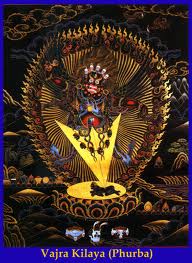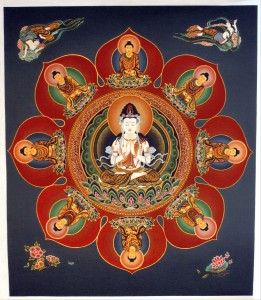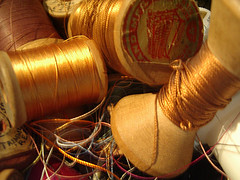The following is an excerpt from a teaching by Jetsunma Ahkon Lhamo offered during a Phowa retreat:
So, you are training; you are preparing. You know what to expect. You know that you will go into a state that is unfamiliar to you, with senses that act differently than your senses act now, although they will be similar in some ways. You know that you will have many choices. You know you will see things that are uncomfortable for you and unfamiliar; you will see things that are more familiar. You are beginning to understand that there are things that you should look for and things you should go toward, but mostly, you have heard the most precious piece of information. You will hear it again and again and again. And that is that these things that you see in the bardo are not to be feared. They are displays and emanations of your own mind. No matter what they look like, no matter what you see, no matter how unfamiliar you are. From the very brightest lights to the very most confused and deluding negative lights… The lights that emanate from the hell realm are things that are an expression of some particular aspect of your own nature—whether it is your nature in a state of defilement, or the samsaric elements of your nature, or whether it is your nature in this most pure form, which is your ultimate primordial Buddha nature. Everything that you see in the bardo will be you. There is nothing to run from; it is childish and stupid to run. You cannot run away from yourself; it will pursue you. As you will see in the bardo, there are cycles of coming back and trying to choose again, coming back and trying to choose again. You’ll see that as we move on. So let’s move on.
Now we have come to the part of the bardo where the peaceful Buddhas have finished appearing. In order for you to be continuing in the bardo now, this means that the peaceful Buddhas have appeared. You have seen your nature in all its different elements and displays;. You have seen the displays of the qualities of your nature, but you did not recognize them, and you did not follow them. Fortunately, you also saw the displays that are sort of vibrational showings or displays, and also ways to enter the different six realms of cyclic existence, and so far you have not entered those either, for whatever reason.
It is hard to say what the reasons are. It can be that habitually you are a person of extreme caution and are unwilling to do anything without a great deal of examining. Of course that won’t work, because if you have not been trained, you are examining bardo with the same, if not more, delusion than the delusion that you have in life, when you could not examine enough to be able to get yourself out of samsara anyway. So that kind of examination will not serve you. It is this training and devotion to one’s spiritual mentor that will save you. That is what actually works. But somehow you’ve managed not to go into rebirth at this time. You are still in the bardo. Now at this time, the wrathful deities appear.
When the wrathful deities appear, they do so singularly and they do so en masse. They appear to you in different ways—it’s a very dynamic kind of presentation. It is also with the peaceful Buddhas, but with the wrathful Buddhas it is even more so. The reason why is that the wrathful Buddhas—you’ve seen pictures of them, or the next time you go into the Prayer Room you should look at some of the wrathful Buddhas and you will see—they are downright spooky looking. And you ask yourself, “Whoa, what, are they like Guido and Raoul, the hit men from New York?” What is it? When the good guys can’t talk you into it, the bad guys beat you into it? You must wonder what the wrathful deities are. The wrathful deities actually are symbolic and are meant to display the aspect of enlightened compassion and method that is forceful, dominating, expanding, progressing, purifying. These are all very active words, aren’t they? They’re very dynamic and active words. There are, of course, displays and expressions of one’s Buddha nature that appear as absolute stillness and absolute emptiness, and very peaceful kind of display. Of course, that is the wisdom aspect of one’s own nature. But what is the method aspect of one’s own nature? If wisdom and method are non-dual and completely inseparable, as they are, looking at them from the purely awakened state, then it must also be, just as much, if stillness is your nature, then movement is your nature. They are the same and indistinguishable. If emptiness is your nature, then fullness is your nature, because in truth, in the awakened state, emptiness and fullness cannot be distinguished. They are not only inseparable, they are not distinguishable. It is only we that separate emptiness from fullness and peacefulness from aggression or activity.
So, as in the case of Vajrakilaya, which many of you here practice, Vajrakilaya is the very wrathful display of Vajrasattva. Vajrasattva. Who could be more peaceful than that deity who is meant to purify all of our samsaric afflictions, who has the capacity to purify all of our “sins,” all of our afflictions, all of our ego clingings, our hatred, our greed, and our ignorance? Who is more forgiving and more peaceful than that? And yet the wrathful display of Vajrasattva is Vajrakilaya. Does that mean that Vajrasattva has PMS and on a monthly basis emerges as Vajrakilaya in a real bad mood? Do you think that’s what it is? No, that’s not what it is; of course it’s not. It is the same nature. It is the same. Vajrakilaya is completely indistinguishable from Vajrasattva. They are the same in their function. They are the same in their capacity. They are the same in their enlightenment. But they are different in the display of method. That is all.
Copyright © Jetsunma Ahkon Norbu Lhamo All rights reserved


